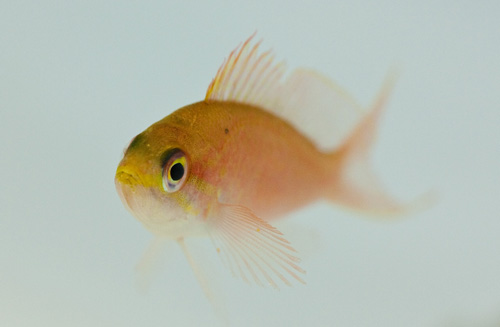 This time of year, when I get a call from my friend, Bob Janke, it usually means he’s on his way home from a snorkeling trip in Shinnecock or Moriches bay and he’s giving me a tropical fish report. When I find multiple missed calls and text messages, it usually means he either caught something that he can’t identify or he caught something really cool, like a French angelfish. Two years ago he brought me a creole fish (Paranthias furcifer), that turned out to be a new species for New York State and a range record for the species. When I called Bob back yesterday, he described a small fish that he caught hiding among the cracks of a rotting piling in 3 feet of water in Shinnecock bay as “very similar in shape and behavior to the creole fish, but pink rather than maroon.” I immediately thought of the Anthiinae, the subfamily of Serranids that includes Anthias and related genera, but I tried not to get too excited. As far as I know, there are no shallow-water members of this group in the Atlantic.
This time of year, when I get a call from my friend, Bob Janke, it usually means he’s on his way home from a snorkeling trip in Shinnecock or Moriches bay and he’s giving me a tropical fish report. When I find multiple missed calls and text messages, it usually means he either caught something that he can’t identify or he caught something really cool, like a French angelfish. Two years ago he brought me a creole fish (Paranthias furcifer), that turned out to be a new species for New York State and a range record for the species. When I called Bob back yesterday, he described a small fish that he caught hiding among the cracks of a rotting piling in 3 feet of water in Shinnecock bay as “very similar in shape and behavior to the creole fish, but pink rather than maroon.” I immediately thought of the Anthiinae, the subfamily of Serranids that includes Anthias and related genera, but I tried not to get too excited. As far as I know, there are no shallow-water members of this group in the Atlantic.  Five minutes later, Bob pulled his car up to the loading dock of the Aquarium and got out, still dripping wet, holding a clear plastic jar filled with water. I noticed a short bigeye (Pristigenys altus) and some assorted butterflyfish swimming around. Covering the bottom of the jar was a layer of loose tunicates, blue mussels, and other invertebrates as well as some seaweed. I moved the contents around with my hand, bracing myself for disappointment, when suddenly a tiny Anthias popped out from under one of the mussels. I let out an audible gasp. Bob and my fellow aquarists moved in for a closer look. “This is huge” I said. When I asked Bob if he would mind if I took it inside for some photos, he told me he was donating it to us. At that point I had to try hard to contain my excitement, but I wasn’t doing a very good job. After a lot of animated speculation, I got photos out to my most trusted deep-water basslet experts: Carol Baldwin of the Smithsonian Institute and Forrest Young of Dynasty Marine. We all agreed that it has to be one of two species: Hemanthias vivanus (red barbier) or Choranthius tenuis (threadnose bass), both of which are usually found at depths of 200-2000ft (60-600m) .… More:
Five minutes later, Bob pulled his car up to the loading dock of the Aquarium and got out, still dripping wet, holding a clear plastic jar filled with water. I noticed a short bigeye (Pristigenys altus) and some assorted butterflyfish swimming around. Covering the bottom of the jar was a layer of loose tunicates, blue mussels, and other invertebrates as well as some seaweed. I moved the contents around with my hand, bracing myself for disappointment, when suddenly a tiny Anthias popped out from under one of the mussels. I let out an audible gasp. Bob and my fellow aquarists moved in for a closer look. “This is huge” I said. When I asked Bob if he would mind if I took it inside for some photos, he told me he was donating it to us. At that point I had to try hard to contain my excitement, but I wasn’t doing a very good job. After a lot of animated speculation, I got photos out to my most trusted deep-water basslet experts: Carol Baldwin of the Smithsonian Institute and Forrest Young of Dynasty Marine. We all agreed that it has to be one of two species: Hemanthias vivanus (red barbier) or Choranthius tenuis (threadnose bass), both of which are usually found at depths of 200-2000ft (60-600m) .… More:
The post Deep-water Anthias collected in Long Island bay…in 3ft of water! appeared first on Reefs.com.